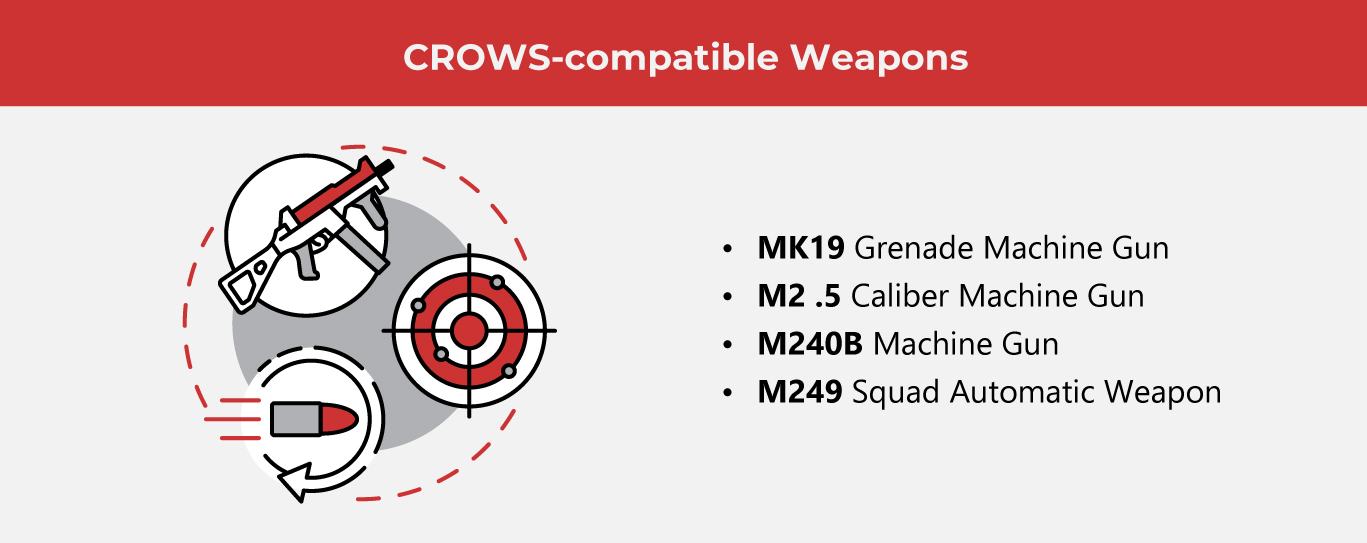Why CROWS are a Soldier’s Best Friend

Remote weapons systems (RWS) have existed in some form or manner for many years now, but since 2001, its most current incarnation has been helping warfighters fight on-ground battles more efficiently and safely.
In the United States, the program for the acquisitions and sustainment of such weapons systems for all its army vehicle programs is called CROWS, or Common Remotely Operated Weapons Stations. The introduction of CROWS has been instrumental in keeping troops safer on the field.
RWS: Modern-day armor for the troops
The RWS is a stable mount on top of a war vehicle that supports several weapons. Decades ago, soldiers operating such mounts on top of tanks would be required to position themselves alongside the weapons mount, exposing their heads and limbs during combat.
Today, the RWS eliminates this risk by protecting soldiers from sticking out their extremities. Operators are 100% covered and may operate the weapons system from inside the war vehicle. Protection from snipers, not to mention harsh environments and weather conditions is the biggest advantage of having an RWS in military operations.
The RWS contains sensor suites and combat or fire control software. Advanced RWS allows for improved target acquisition and what the military refers to as “fire-burst target engagement”, or high-speed rapid firing.
The technology of CROWS takes into account the requirements soldiers need for targets, which is why the system features target reference points for multiple locations. Everything is programmable; from its cameras to its sensors to its firearms. Surveillance scanning, automatic target tracking, and even no-fire zones are programmable, saving soldiers precious time and allowing them to act more efficiently in the face of imminent threats.

New CROWS from Norway
In October 2022, it was announced that Scandinavian electronics manufacturing company Kitron will be partnering up with Kongsberg, a leading weapons stations system provider. Kitron will now be Kongsberg’s lead electronics supplier for their RWS.
Kongsberg’s impressive portfolio boasts of delivering 20,000 units of RWS to twenty-eight nations, including the United States, the United Kingdom, Germany, and Japan.
Kongsberg has named their line of remote weapons systems The Protector, of which there are eight types, each one catering to specific military functions. There are RWS for land, sea, and air.
One of its most popular RWS is called The Protector RS2. An RWS for land, it is the most compact RWS in the Kongsberg line and is an improvement of existing RWS technology. The Protector RS2 has been deployed in Afghanistan and Iraq. The Protector RS2 has superior anti-sniper systems in place.
An RWS such as the Protector RS2 provides light years’ worth of improvements and innovations from legacy weapons such as ring-mounts and pintle-mounted weapons systems. Today’s RWS are lighter and customizable, allowing operators to adapt to the most suited weapons on the field.
The programmability and modularity of RWS are invaluable to soldiers out in the field. With these weapons systems, they can deploy the best strategies more efficiently and safely, taking out the guesswork in high combat situations.
When it comes to naval RWS, there’s the Protector RS4 Naval. What this does is protect warships from threats, and is equipped with advanced capabilities for protection and security in the water. These are made specifically for harsh conditions at sea and are suited to any type of operation or mission.
The Protector RS4 Naval is capable of carrying light to medium-sized payloads ranging from small caliber weapons to medium-sized canons.
How Soldiers Benefit from RWS
Remote weapons systems have this mission: to improve a soldier’s weapons performance through better target identification and engagement while firing remotely. The military units that are equipped with RWS are Infantry, Artillery, Armor, Cavalry, Engineer, Chemical, and Military Police.
Safety, efficiency, and precision are top of mind when it comes to having RWS out in the field. Whether the soldier’s war vehicle is static or mobile, they can operate weapons quickly and accurately. The RWS allows soldiers range too, and help the soldier engage their targets whether day or night, rain or shine.
It not only provides much-needed cover for them. These RWS serve as the soldier’s extra eyes and ears. Thanks to the advanced sensors of this technology which includes video cameras, thermal cameras, and laser rangefinders, soldiers have a 360-degree view of their environment.
Some enhancements being developed for future RWS are the integration of other weapons, improvements on “escalation-of-fire” systems, better sniper detection, improved situational awareness, increased elevation for weapons, and an enhanced commander’s display.
It won’t be very long before smart technology and IoT are integrated into RWS. As we accelerate towards an automated future using digital road maps, it’s only a matter of time before we see larger developments in RWS and other systems that allow us to defend our nations. Now, if only we can figure out a way to do this humanely.
As one of the Top 19 EMS companies in the world, IMI has over 40 years of experience in providing electronics manufacturing and technology solutions.
We are ready to support your business on a global scale.
Our proven technical expertise, worldwide reach, and vast experience in high-growth and emerging markets make us the ideal global manufacturing solutions partner.
Let's work together to build our future today.




